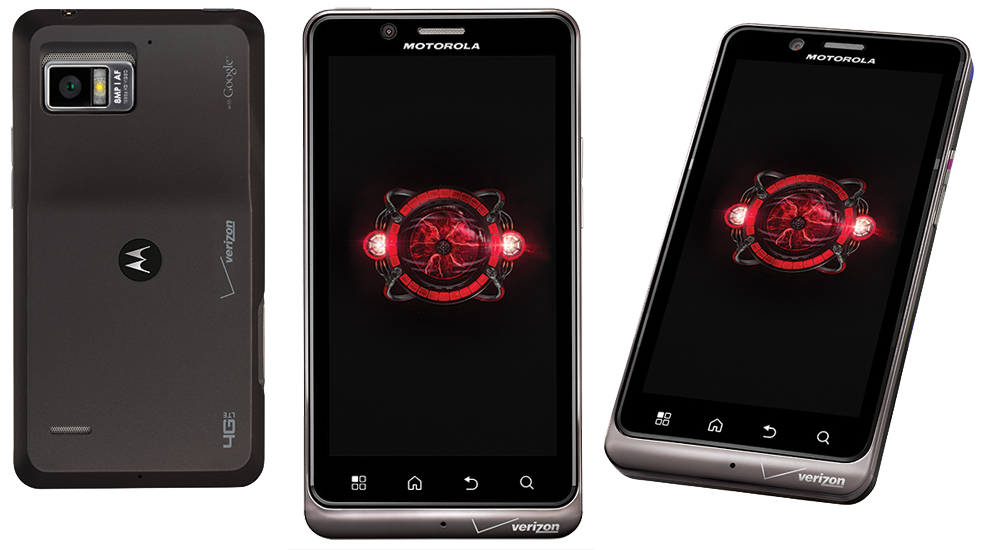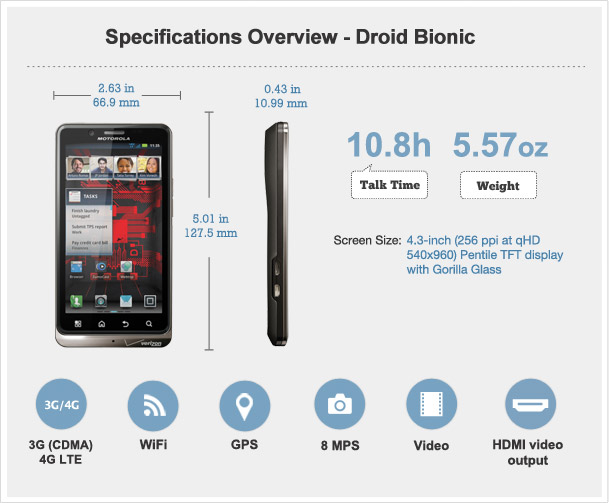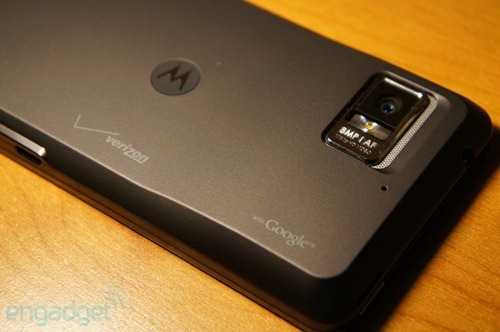The Droid Bionic has had a rough life. It was first announced at CES in the beginning of 2011, but was then torn apart and completely rebuilt. Motorola’s decision to start over with the phone caused it to be delayed for months, but it was finally released last month on Verizon Wireless. With it’s new internals, the Bionic now sports a dual-core 1 GHz processor, 4.3 inch HD display, 8-megapixel auto-focus camera with flash, and 1 GB of of RAM. Oh, and don’t forget about its connection to Verizon’s 4G LTE network. So, was it worth the wait and it’s $300 price tag? We think it might be.
Design
The Bionic is a good looking phone, there’s no doubt about that, but there’s really nothing that makes it stand out above other Verizon phones. It’s the thinnest LTE phone on the network, but definitely not the thinnest smartphone available. It’s also thicker around the top of the phone where the camera is located, something I’m usually not a fan of for fear it will flip out of my hand. But the Bionic has a very smooth and gradual transition from thick to thin, resulting in a better grip and easing my fears of dropping it. As you may expect on modern phones, the screen is made of super-strong Gorilla Glass, and it has a slight bevel around the edges to give it a more defined look. Overall the Bionic is a good, solid looking phone, but nothing to drool over.
OS
The Bionic runs on Android 2.3 Gingerbread, not the most recent Android release (nicknamed Ice Cream Sandwich), but it will almost certainly receive the upgrade sometime over the next few months. Motorola has customized the OS with the hope of making it easier to use, but that’s unfortunately not always the case. One of the positive enhancements is the ability to group applications in the app drawer. This makes it much easier to keep things organized and quickly find what you’re looking for. Another enhancement is the addition of a grid when moving icons and widgets around your home screen. It’s nothing huge, but it’s the little things like this that add up for an overall improved experience.
Speed
As mentioned before, this is a Verizon LTE device. While I don’t want to get into Verizon’s service and a review of their 4G network, I do want to mention that the Bionic does a great job utilizing the LTE. Combined with the speed of the dual core processor, the Bionic pulls down websites, flash content, YouTube videos, and just about anything else very quickly. Unlike some other carriers, Verzion’s 4G LTE network now covers about half the country, so receiving these speeds on your Bionic won’t be unheard of.
Battery
The Bionic boasts the largest battery on an LTE device yet, which is great since using 4G can quickly drain a battery. It’s no miracle battery, but every little bit counts when you’re on the go. You’ll likely get a days usage out of a single charge with light to moderate use, but if you’re a heavy user or plan on tethering you might want to bring an extra battery. If you plan on using it a lot and don’t want to carry an extra battery, there’s also an extended battery available, though the tradeoff is obviously a thicker phone.
Camera
By default the Bionic is set to take 6MP shots, even though it has an 8MP camera. It does this to make the picture better fit the phone’s display, and it’s easy enough to go into settings and change it to the full 8MP. Overall the camera is okay. It’s very much like the Droid X and X2’s cameras in that the pictures are a bit underexposed and they often lack contrast. There’s also a noticeable lag when focusing. Click the shutter button and it will focus, and focus, and focus, and eventually take the shot. Whether or not the actual photo is in focus at that point is a gamble. The Bionic’s camera will do fine for everyday shots, but this is one area I wish they would have improved when rebuilding the phone.
The Bionic records video at 1080p, but is set at 720p by default. Again, a quick change in the settings is all that’s needed to get the full recording resolution. The video is a noticeable better quality than the video found on the Droid X and X2, but it’s still not perfect with some noticeable focus hunting happening when objects get close up. Even with the noticeable focusing, the video recording will easily suffice for most user’s needs.
Final Thoughts
The Droid Bionic is an exceptionally good phone. No, it doesn’t have an eye-catching design, or a miracle battery, or a perfect camera, but that phone doesn’t exist yet. The Bionic is about as close as you’re currently going to get to perfect. It has powerful insides with blazing fast speeds powered by Verizon’s ever-expanding LTE network. Being so new, it will almost certainly be upgraded to Android 4.0 Ice Cream Sandwich at some point over the next few months. As for it’s $300 price tag, that is ultimately up to you. If you plan on keeping the phone for a 2-year contract (as most probably will) then I would say go for it. Spend the money now and you will have a phone that will do you well for the next two years. It has the power and speed to run the newest apps and probably any that will be created in the time you own the phone.


